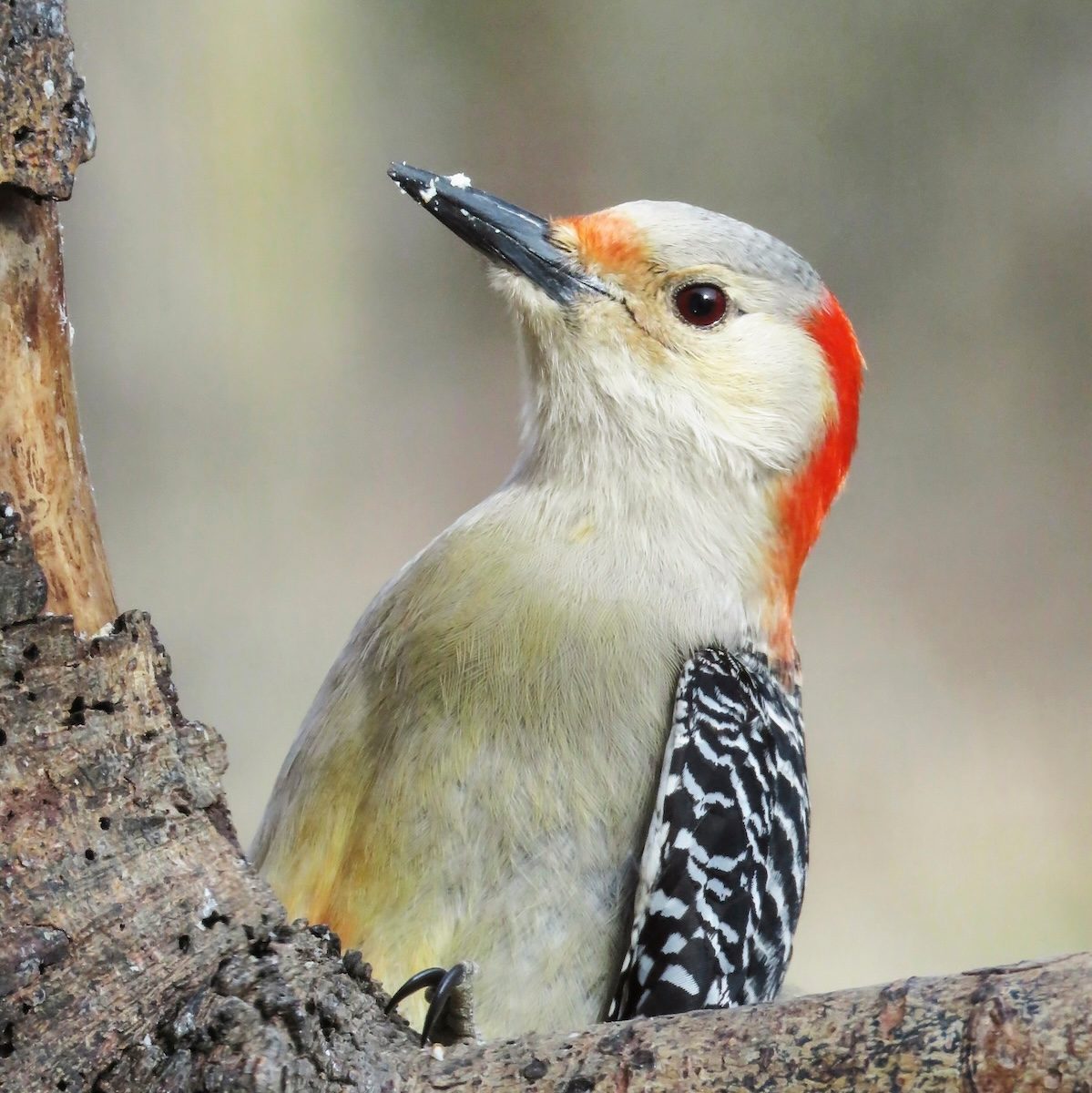Meet the woodpecker with a puzzling moniker and a big appetite for suet. Learn what a red-bellied woodpecker looks like and sounds like.

All About the Red-Bellied Woodpecker

On This Page
What Does a Red-Bellied Woodpecker Look Like?

With zebra-like stripes on the backs and wings, the red-bellied woodpecker has a few look-alike relatives, such as the gila woodpeckers and golden-fronted woodpeckers of the Southwest. It’s thanks to one distinguishable characteristic—a red head—that these woodpeckers are frequently confused with the less common red-headed woodpecker species, which shows a full head of bold red feathers.
And then there’s the ambiguous red belly—a hard-to-see, faint crimson color on their undersides. This makes many bird-watchers wonder if the person who named this woodpecker was seeing things. It’s only when the light hits the stomach just right that the blush-colored feathers are most noticeable. Then you finally see how this flier got its name.
Typical woodpecker features include stiff tails to prop their bodies up against tree trunks, and feet with two toes facing forward and two pointing backward. That foot structure helps them grasp branches and bark as they navigate up and around tree trunks, on the hunt for insects. They measure 9-1/4 inches with a wingspan of 16 inches.
Check out more photos of common North American woodpecker species.
Males, Females and Juveniles

Like many species in the woodpecker family, male and female red-bellieds look slightly different. Males sport full red foreheads, caps and napes. Females have red napes and just a touch of ruby at the base of their bills.
Their juvenile offspring, however, have plain, nondescript heads with a subdued red hue. Some young birds lack the red completely, but they’re still recognizable by the narrow black-and-white barring on their backs.
Discover mind-blowing woodpecker facts you should know.
What Does a Red-Bellied Woodpecker Eat?

Omnivorous red-bellied woodpeckers stick their barb-fringed tongues out 2 inches beyond their bills. This, and sticky spit, helps them pluck insects from deep crevices.
To lure these lively and desirable woodpeckers to your backyard feeding station, serve a variety of their favorite foods. Suet is a must, especially in winter. Sunflower seeds and peanuts are a hit, too. And then sweeten the deal with sugar water, fruit and grape jelly. Outside the backyard, they also eat insects, acorns and berries.
In autumn, red-bellied woodpeckers store seeds and nuts in cracks in tree bark. They go back to their hiding spots for an easy-to-find meal come winter.
Learn how to tell the difference between downy and hairy woodpeckers.
Red-Bellied Woodpecker Call
As red-bellieds swoop in to your feeders for a snack, listen for the exuberant, guttural quirr quirr quirr chatter. Unlike most bird species, both males and females vocalize throughout the year. The sound is a favorite of many backyard birders.
Listen to the red-bellied woodpecker’s song.
Bird songs provided by the Cornell Lab of Ornithology.
“The bird’s distinctive call announces its presence at our feeders,” says Birds & Blooms reader Stephen Holland of Sandown, New Hampshire. “The unique coloring of a red head and striped back makes it stand out in all seasons.”
Learn how to identify a pileated woodpecker.
Nest and Eggs

The mated pair excavates a nesting cavity in an old stump or tree. Then the female lays four to six white eggs per clutch. Both parents put in the work to incubate the eggs per clutch, with males often taking the night shift.
It’s not uncommon for the pair to aggressively defend their nest against potential predators, including starlings, snakes or even other woodpeckers.
Learn more about woodpecker nests and eggs.
Range Map and Habitat

Red-bellied woodpeckers are widespread in the eastern half of the United States. They’re more common in the southern states. But the species is on the move and the breeding range has extended north over the last century. Look for these birds in wooded areas and residential areas with plenty of trees and shrubs.

Range maps provided by Kaufman Field Guides, the official field guide of Birds & Blooms.
Next, meet the sapsucker birds: woodpeckers with a sweet tooth.






















